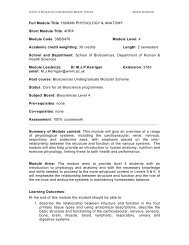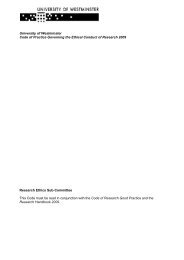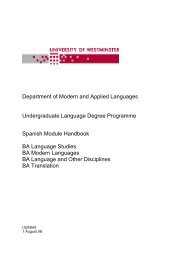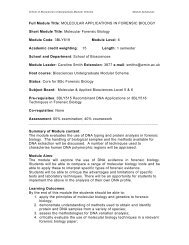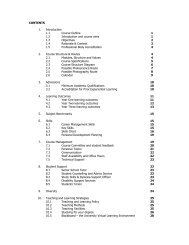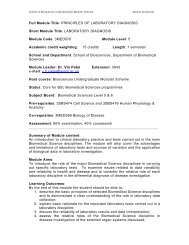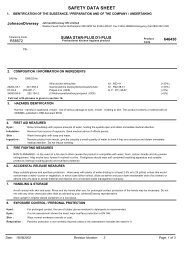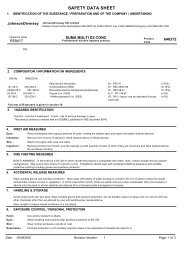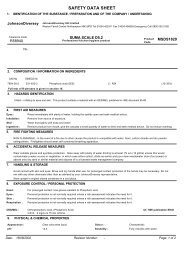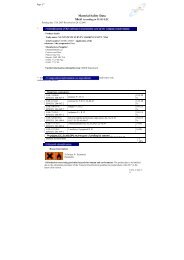referencing your work - University of Westminster
referencing your work - University of Westminster
referencing your work - University of Westminster
Create successful ePaper yourself
Turn your PDF publications into a flip-book with our unique Google optimized e-Paper software.
ISLS Information Systems and Library Services<strong>referencing</strong> <strong>your</strong> <strong>work</strong>
Referencing <strong>your</strong> <strong>work</strong>2008PageSection2 1 What does <strong>referencing</strong> mean?2 Why should I include references in my <strong>work</strong>?3 What’s so bad about plagiarism?4 How do I know if I’m plagiarising?5 How do I reference my <strong>work</strong>?3 6 What do I need to include in a reference?6.1 details to note for books6.2 details to note for journal and newspaper articles6.3 details to note for online sources4-5 7 Referencing using the Harvard system8 Citing references in the text8.1 citing the author in the text8.2 using direct quotes8.3 citing more than one author8.4 citing three or more authors8.5 citing a chapter or section8.6 citing a <strong>work</strong> without an author8.7 citing several <strong>work</strong>s by the same author written in the same year8.8 citing secondary sources6-12 9 Writing a Bibliography or List <strong>of</strong> references9.1 Printed booksReference to a book with one authorReference to a book with two authorsReference to a book with three or more authorsReference to a chapter or section9.2 Electronic books (e-books)9.3 Print journals and newspapers9.4 Electronic journals (e-journals)E-journal article accessed via full text databaseE-journal article accessed via a website on the open Internet9.5 Reports9.6 Conference papers9.7 Websites, web pages and PDF documents9.8 Online images9.9 DVDs and videocassettes10 More informationUNIVERSITY OF WESTMINSTER1<strong>referencing</strong> <strong>your</strong> <strong>work</strong>
UNIVERSITY OF WESTMINSTER2<strong>referencing</strong> <strong>your</strong> <strong>work</strong>1 What does4<strong>referencing</strong> mean?23When writing an academic piece <strong>of</strong> <strong>work</strong>you need to acknowledge any ideas,information or quotations which are the<strong>work</strong> <strong>of</strong> other people. This is known as<strong>referencing</strong> or citing.Why should I includereferences in my <strong>work</strong>?You should include references in order to:● acknowledge the <strong>work</strong> <strong>of</strong> others● provide evidence <strong>of</strong> <strong>your</strong> own research● illustrate a particular point● support an argument or theory● allow others to locate the resourcesyou have usedAnd most importantly:● avoid accusations <strong>of</strong> plagiarismWhat’s so badabout plagiarism?Plagiarism is considered cheating, as youhave taken the words or ideas <strong>of</strong> otherpeople and passed them <strong>of</strong>f as <strong>your</strong> own.The <strong>University</strong> takes cases <strong>of</strong> plagiarismvery seriously. If you are caught plagiarisingyou will face disciplinary procedures whichcould ultimately result in <strong>your</strong> expulsion.Go to www.wmin.ac.uk/academicconductfor more details.5How do I knowif I’m plagiarising?A tutorial on how to use expert sourcesproperly and avoid plagiarism isavailable on Blackboard. More advice on<strong>referencing</strong> is also available on theAcademic Writing Centre’s website.Go to www.wmin.ac.uk/AWCfor more details.The best advice is, if in doubt cite.How do I referencemy <strong>work</strong>?Your references should be consistent andfollow the same format. Various systemshave been devised for citing references, butmost Schools use the Harvard system.Check <strong>your</strong> course or module handbookto find out which system <strong>your</strong> Schooluses. If you are unsure, ask <strong>your</strong> tutorbefore handing in <strong>your</strong> assignment. Failureto follow the School’s preferred systemmay lose you marks.
6What do I need to includein a reference?References consist <strong>of</strong> certain details aboutthe source you are using. It is a good idea tomake a note <strong>of</strong> all the relevant details whilstconducting <strong>your</strong> research. This will save youtime later.The details you should note during<strong>your</strong> research are:6.1 For books:● Authors/editors● Year <strong>of</strong> publication● Edition where one is given● Title <strong>of</strong> book● Page numbers (for direct quotes)● Chapter title, author and page numbers(if chapters have different authors)● Name <strong>of</strong> publisher● Place <strong>of</strong> publication● URL (for electronic books only) and name<strong>of</strong> e-book provider● Date accessed (for electronic books only)6.2 For journal and newspaper articles:● Authors● Year <strong>of</strong> publication● Title <strong>of</strong> article● Name <strong>of</strong> journal● Volume, issue or part number (or day andmonth), page numbers● URL (for electronic journals only)● Date accessed (for electronic journals only)UNIVERSITY OF WESTMINSTER3<strong>referencing</strong> <strong>your</strong> <strong>work</strong>6.3 For online sources e.g. websites:● Authors● Year <strong>of</strong> publication● Title <strong>of</strong> document● URL● Date accessed(N.B. What if I can’t find the author? In the case<strong>of</strong> a publication, most especially Internet pageswhere you are unable to identify an actual personas the author, use the name <strong>of</strong> the company ororganisation shown most prominently.)
UNIVERSITY OF WESTMINSTER4<strong>referencing</strong> <strong>your</strong> <strong>work</strong>7 Referencing using8the Harvard systemReferences will be cited in <strong>your</strong> <strong>work</strong>in two places: -● Where a source is referred to in the text● In a list (the Bibliography/List <strong>of</strong>references) at the end <strong>of</strong> the assignmentCiting referencesin the text8.1 Citing the author in the textIn the Harvard system whenever a referenceto a source is made, its author's surnameand the year <strong>of</strong> publication are inserted inthe text as in the following examples.Dogs were the first animals to bedomesticated (Sheldrake, 1999).If the author's name occurs naturally in thesentence the year is given in brackets.Sheldrake (1999) asserts that dogs were thefirst animals to be domesticated.8.2 Using direct quotesIf you quote directly from a source you mustinsert the author’s name, date <strong>of</strong> publicationand the page number <strong>of</strong> the quotation.‘The domestication <strong>of</strong> dogs long predatedthe domestication <strong>of</strong> other animals.’(Sheldrake, 1999, p.5).The page number should be given at the end<strong>of</strong> the quote, in separate brackets ifnecessary, as in the example below.Sheldrake (1999) asserts that the‘domestication <strong>of</strong> dogs long predated that<strong>of</strong> other animals.’ (p.15).8.3 Citing <strong>work</strong>s by more than one authorIf <strong>your</strong> source has two authors you shouldinclude both names in the text.Anderson and Poole (1998) note that a‘narrow line <strong>of</strong>ten separates plagiarism fromgood scholarship.’ (p.16).
8.4 Citing <strong>work</strong>s by three ormore authorsIf there are three or more authors you shouldinclude the first named author and then add‘et al.’ in italics followed by a full stop. This isan abbreviation <strong>of</strong> ‘et alia’ which means ‘andothers’ in Latin.8.7 Citing <strong>work</strong>s by the same authorwritten in the same yearIf you cite two or more <strong>work</strong>s written in thesame year by the same author, then you mustdifferentiate between them in both the textand <strong>your</strong> List <strong>of</strong> references by listing them asa,b,c etc. (see 9.3).UNIVERSITY OF WESTMINSTER5In the United States revenue fromcomputer games now exceeds that <strong>of</strong>movies (Kline et al., 2003).8.5 Citing a chapter or sectionWhen referring to a chapter or section whichis part <strong>of</strong> a larger <strong>work</strong>, you should cite theauthor <strong>of</strong> the chapter not the editor <strong>of</strong> thewhole <strong>work</strong>. (see 9.1 for a typical example.)The sea level has risen by approximately10cm in the last 100 years (Mason, 1999).8.6 Citing a <strong>work</strong> without an authorIf an organisation or company(e.g. Department <strong>of</strong> Health, Arcadia GroupLimited) is named as the author <strong>of</strong> a <strong>work</strong>rather than a person, you should cite theirname. Make sure you use the same version<strong>of</strong> the organisation name in both the text andList <strong>of</strong> references (e.g. always use ‘Department<strong>of</strong> Health’, don’t abbreviate to ‘DoH’).Natural selection can cause rapid adaptivechanges in insect populations (Ayala, 1965a)and various laboratory experiments havebeen conducted to assess this theory(Ayala, 1965b).8.8 Citing secondary sourcesWhen citing secondary sources (i.e. anauthor refers to a <strong>work</strong> you have not read)cite the secondary source, but include thename <strong>of</strong> the author and date <strong>of</strong> publication <strong>of</strong>the original source in the text. Only thesecondary source should be listed in <strong>your</strong>references. You should only cite secondarysources if you are unable to read the originalsource <strong>your</strong>self.Sheff (1993) notes that Nintendo investedheavily in advertising (cited in Kline et al.,2003, p.118).<strong>referencing</strong> <strong>your</strong> <strong>work</strong>Spain became a member <strong>of</strong> the UnitedNations in 1955 (United Nations, 2000).
UNIVERSITY OF WESTMINSTER69Writing a Bibliographyor List <strong>of</strong> referencesThe List <strong>of</strong> references appears at the end<strong>of</strong> <strong>your</strong> <strong>work</strong> and gives the full details <strong>of</strong>everything that you have cited in the text inalphabetical order by the author’s surname.Sometimes this List <strong>of</strong> references is alsocalled the Bibliography.9.1 Printed booksPrinted books should be referenced usingthe following format and punctuation.● Author/editor’s surname and initials.,● (Year <strong>of</strong> publication).● Title <strong>of</strong> book: including subtitles.(in italics or underlined)● Edition. (if applicable)● Place <strong>of</strong> publication: (followed by a colon)● Name <strong>of</strong> publisher.<strong>referencing</strong> <strong>your</strong> <strong>work</strong>Sometimes a tutor requires the Bibliographyto be more than just a list <strong>of</strong> references.S/he may also want to see the full details<strong>of</strong> everything you have read during thepreparation <strong>of</strong> this piece <strong>of</strong> <strong>work</strong>,regardless <strong>of</strong> whether or not you cited itin the text.Reference to a book with one authorSheldrake, R., (1999). Dogs that know whentheir owners are coming home: and otherunexplained powers <strong>of</strong> animals. London:Arrow Books.Sometimes a tutor will want to seedetails <strong>of</strong> those items, but in a separatelist from the List <strong>of</strong> references, called eithera Bibliography or Further reading.Reference to a book with two authors Anderson, J. and Poole, M., (1998).Assignment and thesis writing. 3rd ed.Chichester: John Wiley & Sons.Remember to check exactly what <strong>your</strong> Schoolor Department means by these terms.All sources must be referenced in aconsistent way. The examples given hereprovide a guide to the format andpunctuation you should use.
Reference to a book with threeor more authorsSome Schools allow you to use ‘et al.’ in <strong>your</strong>List <strong>of</strong> references, others e.g. WBS requireyou to list ALL the authors. Make sure youcheck which style is preferred by <strong>your</strong> tutoror School.This example uses ‘et al.’ instead <strong>of</strong>listing all the authors.Kline, S. et al., (2003). Digital play: theinteraction <strong>of</strong> technology, culture andmarketing. Montreal: McGill-Queen’s<strong>University</strong> Press.This example lists all the authors.Kline, S., Dyer-Witheford, N., De Peuter, G.,(2003). Digital play: the interaction <strong>of</strong>technology, culture and marketing. Montreal:McGill-Queen’s <strong>University</strong> Press.9.2 Electronic booksElectronic books (e-books) should bereferenced using the following format andpunctuation.● Author/editor’s surname and initials.,● (Year <strong>of</strong> print publication). (date <strong>of</strong>electronic publication can be used if noprint publication date is available)● Title <strong>of</strong> book: including subtitles.(in italics or underlined)● Edition. (if applicable)● [online]● Place <strong>of</strong> publication <strong>of</strong> print version:(followed by a colon)● Name <strong>of</strong> print publisher.● Available from: (location <strong>of</strong> e-book,e.g. Safari Tech Books Online).● ● [Accessed (enter date you viewedthe book)].UNIVERSITY OF WESTMINSTER7<strong>referencing</strong> <strong>your</strong> <strong>work</strong>Reference to a chapter or sectioncontained in a larger <strong>work</strong>Mason, J., (1999). Recent developmentsin the prediction <strong>of</strong> global warming.In: McVeigh, J.C. and Mordue, J.G., (eds.)Energy demand and planning. London:E&FN Spon, pp.34-52.Tanenbaum, A., (2002). Computer net<strong>work</strong>s.4th ed. [online] Upper Saddle River,New Jersey: Prentice Hall. Available from:Safari Tech Books Online. [Accessed 9 August2008].Webster, F., (2002). Theories <strong>of</strong> theinformation society. 2nd ed. [online] London:Routledge. Available from: netLibrary. [Accessed2 June 2006].
UNIVERSITY OF WESTMINSTER8<strong>referencing</strong> <strong>your</strong> <strong>work</strong>9.3 Print journals and newspapersPrint journals should be referenced using thefollowing format and punctuation.● Author's surname, initials., (or Newspapertitle where there is no author,)● (Year <strong>of</strong> publication).● Title <strong>of</strong> article.● Name <strong>of</strong> journal. (in italics or underlined),● Date <strong>of</strong> publication (if applicablee.g. 18 June)● Volume number (in bold) (if applicable)● (Part number), (if applicable)● Page numbers.Britton, A., (2006). How much and how<strong>of</strong>ten should we drink? British MedicalJournal. 332 (7552), 1224-1225.Ayala, F.J., (1965a). Evolution <strong>of</strong> fitness.Science. 150 (3698), 903-905.Ayala, F.J., (1965b). Relative fitness <strong>of</strong>populations. Genetics. 51 (4), 527-544.This example shows a newspaper articlewithout an author.Independent, (2007). Alarm over childdrinkers. Independent. 24 July, 16.9.4 Electronic journals (e-journals)How you cite e-journals varies depending onwhether you accessed the e-journal via afull-text database, or directly from a websiteon the open Internet.If you accessed an article via a database youshould cite the database provider (e.g.Business Source Premier), as they control therights to the online version <strong>of</strong> the article. It isalso acceptable to shorten the URL to that <strong>of</strong>the database’s home page as the URLs <strong>of</strong>individual articles are usually very long, andare only temporary. Ask <strong>your</strong> AcademicLiaison Librarian for advice if you are unsure.E-journal article accessedvia full text databaseElectronic journals should be referencedusing the following format and punctuation.● Author’s surname, initials.,● (Year <strong>of</strong> print publication).● Title <strong>of</strong> article.● Name <strong>of</strong> journal. (in italics or underlined)● Date <strong>of</strong> print publication (if applicable,e.g. May/June)● Volume number (in bold)● (Part number), (if applicable)● Page numbers. (or online equivalent)● [online]● Available from: (name <strong>of</strong> databaseprovider, e.g. Science Direct).● ● [Accessed (enter date you viewedthe article)].Bennett, L. and Landoni, M., (2005). E-booksin academic libraries. The Electronic Library.23 (1), 9-16. [online] Available from: EmeraldFulltext. [Accessed 2 June 2006].
E-journal article accessed via website onthe open InternetElectronic journals should be referencedusing the following format and punctuation.● Author’s surname, initials.,● (Year <strong>of</strong> print publication).● Title <strong>of</strong> article.● Name <strong>of</strong> journal. (in italics or underlined)● Date <strong>of</strong> print publication (if applicable,e.g. May/June)● Volume number (in bold)● (Part number), (if applicable)● Page numbers. (or online equivalent)● [online]● Available from: ● [Accessed (enter date you viewedthe article)].Britton, A., (2006). How much and how<strong>of</strong>ten should we drink? British MedicalJournal. 332 (7552), 1224-1225. [online]Available from: [Accessed 2 June 2006].9.5 ReportsReports should be referenced using thefollowing format and punctuation.● Author/editor’s surname, initials.,● (Date <strong>of</strong> publication).● Title: including subtitles. (in italicsor underlined)● Edition. (if relevant)● Place <strong>of</strong> publication: (followed by a colon)● Name <strong>of</strong> publisher.● Organisation responsible.● Report number.UNIVERSITY OF WESTMINSTER9<strong>referencing</strong> <strong>your</strong> <strong>work</strong>Henwood, M., (1992). Through a glassdarkly: community care and elderly people.London: King’s Fund Institute. King’s FundInstitute. Research report 14.
UNIVERSITY OF WESTMINSTER10<strong>referencing</strong> <strong>your</strong> <strong>work</strong>9.6 Conference papersConference papers should be referencedusing the following format and punctuation.● Author’s surname, initials.,● (Date <strong>of</strong> publication).● Title <strong>of</strong> paper.● In: Editor’s surname, initials.,(if applicable)● Title <strong>of</strong> proceedings. (in italicsor underlined)● Place <strong>of</strong> conference.● Date <strong>of</strong> conference.● Edition (if relevant).● Place <strong>of</strong> publication:● Publisher,● Year <strong>of</strong> publication,● Page numbers <strong>of</strong> contribution.Clifton, J.J., (1989). Hazard prediction.In: Disaster prevention, planning andlimitation. <strong>University</strong> <strong>of</strong> Bradford. 12-13September 1989. Letchworth: TechnicalCommunications Ltd., 1990, pp.51-64.
9.7 Websites, web pages andPDF documentsExercise caution when using web sources asreferences in <strong>your</strong> <strong>work</strong>. Remember thatanyone can publish on the Internet and youmust ensure that any source you use isreliable. If you have any doubts about thecredibility <strong>of</strong> a source, don’t use it.It is a good idea to save a copy <strong>of</strong> anyonline documents cited – subject tocopyright limits - as they can easily beedited, or even disappear altogether.Websites, web pages and PDF documentsdownloaded from the Internet shouldbe referenced using the following formatand punctuation.● Author/editor’s surname, initials.,(or name <strong>of</strong> owning organisatione.g. <strong>University</strong> <strong>of</strong> <strong>Westminster</strong>)● (Year <strong>of</strong> publication).● Title. (in italics or underlined)● Edition. (if applicable, e.g. update 2or version 4.1)● [online]● Place <strong>of</strong> publication: (if known)● Name <strong>of</strong> publisher. (if known)● Available from: ● [Accessed (enter date you viewedthe website)].UNIVERSITY OF WESTMINSTER11<strong>referencing</strong> <strong>your</strong> <strong>work</strong>Holland, M., (2005). Citing references.[online] Poole: Bournemouth <strong>University</strong>.Available from: [Accessed2 June 2006].<strong>University</strong> <strong>of</strong> <strong>Westminster</strong>, (2007). HarryPotter fans to cast spell over <strong>Westminster</strong>.[online] London: <strong>University</strong> <strong>of</strong> <strong>Westminster</strong>.Available from: [Accessed 24 July 2007].
UNIVERSITY OF WESTMINSTER12<strong>referencing</strong> <strong>your</strong> <strong>work</strong>9.8 Online imagesOnline images should be referenced usingthe following format and punctuation.● Artist’s surname, initials., (if known,or name <strong>of</strong> owning organisation)● (Year). (if known)● Title or description <strong>of</strong> image.(in italics or underlined)● [online image]● Available from: ● [Accessed: (enter date you viewedthe image)].Fadden, W., (1779). A plan <strong>of</strong> the city andenvirons <strong>of</strong> Philadelphia. [online image]Available from: [Accessed 25 July 2005].9.9 DVDs and videocassettesDVDs and videocassettes shouldbe referenced using the following formatand punctuation.● Title, (in italics or underlined)● (Year <strong>of</strong> distribution)● Director● [DVD]. or [Videocassette].● Place <strong>of</strong> distribution:● Distribution company.Vertigo, (2005). Directed by A. Hitchcock[DVD]. Los Angeles: Universal Studios.10More informationBibliographic s<strong>of</strong>tware to help organise <strong>your</strong> references is available from http://www.ref<strong>work</strong>s.com/ref<strong>work</strong>sThe output style ‘<strong>University</strong> <strong>of</strong> <strong>Westminster</strong>’ is exactly the same as the one described in this booklet.Ask in the library for more help or information. Always check with <strong>your</strong> tutor about which style <strong>of</strong><strong>referencing</strong> s/he would like you to use.For information on citing resources not mentioned here (e.g. patents) pleasesee British Standard BS 5605:1990. Recommendations for citing and <strong>referencing</strong> published material.BS 5605 is available online from British Standards Online via infoLinX.For information on plagiarism and how to avoid it, see the Academic Registrar’s webpage onacademic conduct at www.wmin.ac.uk/academicconduct and the Academic Writing Centre’sonline tutorial at www.wmin.ac.uk/AWC
<strong>University</strong> <strong>of</strong> <strong>Westminster</strong>Telephone: 020 7911 5000August 2008




